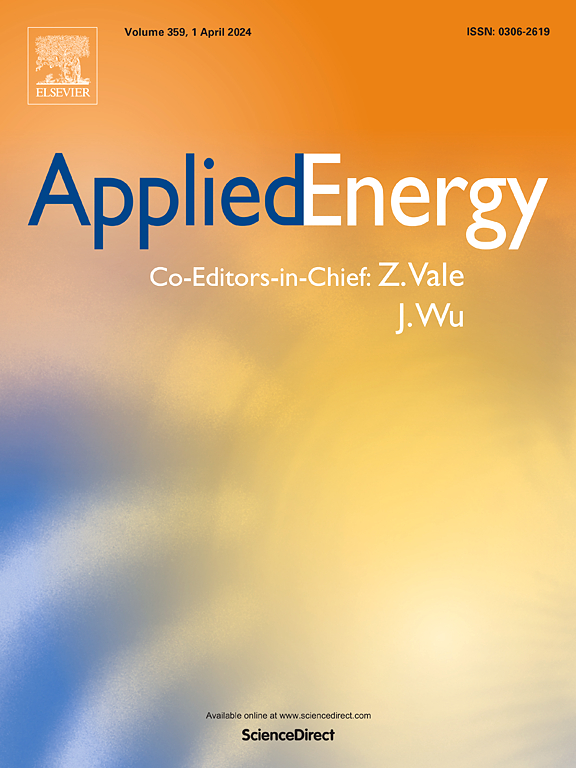结合连续学习和多数字孪生机制的物理编码光伏预测方法
IF 10.1
1区 工程技术
Q1 ENERGY & FUELS
引用次数: 0
摘要
端到端神经网络模型通常被视为黑盒,在光伏发电功率预测中得到了广泛的应用。然而,它们面临着模型适应性差、可转移性和可解释性差的挑战。针对这些问题,本文提出了一种物理编码的光伏预测模型,该模型将端到端网络分解为数据驱动的外部参数预测模型和物理驱动的功率计算模型。功率计算模型具有明确的物理意义,增强了模型的可解释性。设计了持续学习机制,使模型能够快速适应环境变化,减轻模型漂移的影响,提高适应性和可转移性。引入多数字双胞胎协同运行机制,结合其他模型的优势,进一步提高预测精度。模型漂移可分为概念漂移和数据漂移。本文设计了两个场景实验来测试这些漂移。场景1关注概念漂移,实验结果表明,与比较模型的最佳结果相比,本文提出的方法在nMAE、nRMSE和R2指标上分别提高了30.5%、16.5%和1.9%。场景2将模型转移到其他电厂进行数据漂移试验。结果表明,将该方法应用于4号装置时,与最佳对照方法相比,准确率分别提高了45.8%、21%和2.1%;对于5号厂,改进幅度分别为34.1%、18.3%和2.5%。本文章由计算机程序翻译,如有差异,请以英文原文为准。
The physical-encoded Photovoltaic forecasting method combined with continuous learning and multi-digital twins mechanisms
End-to-end neural network models, often seen as black boxes, have been widely used in photovoltaic (PV) power forecasting. However, they face challenges regarding poor model adaptability, transferability, and interpretability. To address these issues, this paper proposes a physical-encoded PV forecasting model, which decomposes the end-to-end network into a data-driven external parameter forecasting model and a physics-driven power calculation model. The power calculation model, with explicit physical meanings, enhances the model's interpretability. A continual learning mechanism is designed to enable the model to quickly adapt to environmental changes, mitigating the impact of model drift and improving adaptability and transferability. A multi-digital twins synergistic operation mechanism is introduced to incorporate the strengths of other models, further enhancing forecasting accuracy. Model drift can be categorized into concept drift and data drift. This paper designs two scenario experiments to test these drifts. Scenario 1 focuses on concept drift, and the experimental results show that the proposed method in this paper achieves improvements of 30.5 %, 16.5 %, and 1.9 % in the nMAE, nRMSE, and R2 metrics, respectively, compared to the best results of the comparison models. In Scenario 2, the model is transferred to other power plants for data drift tests. Results show that when transferred to Plant 4, its accuracy improves by 45.8 %, 21 %, and 2.1 % compared to the best comparison method; for Plant 5, the improvements are 34.1 %, 18.3 %, and 2.5 %.
求助全文
通过发布文献求助,成功后即可免费获取论文全文。
去求助
来源期刊

Applied Energy
工程技术-工程:化工
CiteScore
21.20
自引率
10.70%
发文量
1830
审稿时长
41 days
期刊介绍:
Applied Energy serves as a platform for sharing innovations, research, development, and demonstrations in energy conversion, conservation, and sustainable energy systems. The journal covers topics such as optimal energy resource use, environmental pollutant mitigation, and energy process analysis. It welcomes original papers, review articles, technical notes, and letters to the editor. Authors are encouraged to submit manuscripts that bridge the gap between research, development, and implementation. The journal addresses a wide spectrum of topics, including fossil and renewable energy technologies, energy economics, and environmental impacts. Applied Energy also explores modeling and forecasting, conservation strategies, and the social and economic implications of energy policies, including climate change mitigation. It is complemented by the open-access journal Advances in Applied Energy.
 求助内容:
求助内容: 应助结果提醒方式:
应助结果提醒方式:


